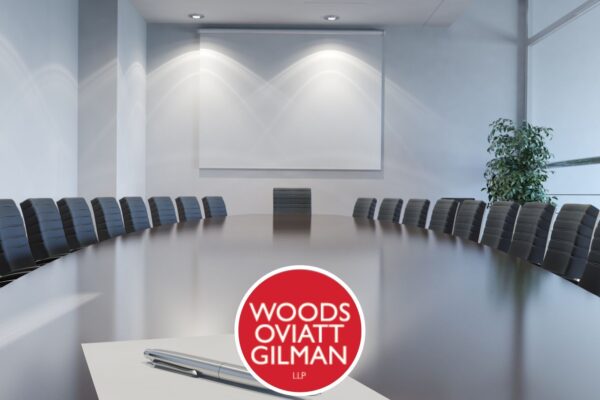2-7-17 As Seen in the Buffalo Law Journal - "WNY Firms Experience Explosive Growth"
WNY firms experience explosive growth
Michael Petro -Editor/Reporter Buffalo Law Journal/Buffalo Business First
FEATURED REPORT
When Lippes Mathias Wexler Friedman moved to 50 Fountain Plaza in 2016, it was an opportunity to upgrade and increase the law firm’s space from its previous home down the road at 665 Main St.
Another plus was Ciminelli Real Estate Corp. offering additional room if the firm ever needed it. Now, just a year later, the firm is already looking for more.
“I didn’t think those opportunities for expansion would come this quickly,” said Kevin Cross, managing partner.
In 2015 when Lippes Mathias started planning the move, 10 to 15 percent of space was earmarked for growth. At the time of the move to 50 Fountain Plaza in January 2016, more than half of that space was already taken up by additional attorneys and staff.
With continued growth that year and so far in 2017, the firm decided it would need another half floor — 7,500 to 8,000 square feet. The firm now occupies 25,000 square feet on the 16th and 17th floors.
“It’s just not bringing in the attorney; it’s also their support staff and other attorneys who would work with them,” Cross said. “It has that kind of impact.”
Lippes Mathias reported the most explosive growth among the region’s 10 largest firms, according to the Law Firms List featured in today’s edition. The firm had a busy 2016, expanding from 49 to 58 attorneys in the Buffalo headquarters.
Using data compiled by Business First for its annual Law Firms List, the Buffalo Law Journal ranked firms with the highest percentage of growth between 2015 and 2016. To be eligible, firms had to have at least 10 attorneys and must have added two or more over the past year.
The Law Offices of Kenneth Hiller had the highest percentage of growth overall, with the number of attorneys going from eight to 13, or growth of 38.4 percent.
Harter Secrest & Emery, also located in 50 Fountain Plaza, was next with 33.3 percent. The firm added 11 attorneys to catapult to 33 overall in Buffalo.
Other top growing firms, according to the list, were Connors LLP, which added four attorneys to reach 17, or 23.5 percent growth, and Woods Oviatt Gilman, which increased from eight to 10 attorneys over the year for 20 percent growth.
Harter Secrest and Woods Oviatt are two of the largest law firms in Rochester where they’re headquartered, and both have made significant commitments to their offices in Buffalo.
Harter Secrest opened here in 1995. According to John Horn, managing partner of the local office, nearly 60 percent of its growth has come from lateral movements by attorneys who came from other firms. The rest is the result of hiring young attorneys and recent law school graduates.
While lateral movements happen in cycles, he said, there has been increased activity in the Buffalo area. It’s certainly been key to his firm success, he said. In addition to several attorneys joining Harter Secrest from other Buffalo firms in 2016, two moved over from its office in Rochester and two others came back to their native Buffalo from out-of-town firms.
The firm’s model for growth is to identify industries and practice areas where there is great interest for existing and prospective clients and then find professionals to meet those needs.
“When attorneys see great opportunities in other firms, they’re acting on it,” Horn said. “We’re seeing big-picture foundational moves for firms (such as mergers and combinations), and on top of that, you’ve got these lateral moves happening.”
Woods Oviatt opened a Buffalo office in September 2014 with six attorneys and added two the next year and two more in 2016. Spurring that was an increase in business for the office’s five equity partners and by being well received in the marketlace, said Chris Henrich, a partner in business and finance in the local office.
“We have the largest firm in Rochester, which is aggressively courting excellent lawyers to create a first-tier legal option in the Buffalo marketplace,” he said. “That’s what we’re doing and that’s what we’re executing. That’s why we’ve grown and that’s why we’ve been successful this way.”
Henrich said the firm’s philosophy of “quality lawyers doing sophisticated work” caught on in Buffalo.
“My belief is that this brand is real, it’s genuine and I can demonstrate that any number of ways in quality of work, performance and turnaround time. And that is going to be felt in this marketplace,” he said. “The people who need that kind of work are going to come to us.”
Connors LLP, a growing boutique litigation firm, has seen an influx of business across all areas of practice and added several people to help with the work, according to managing partner and trial attorney Terrence Connors. Also, when co-founding partner Lawrence Vilardo left for the federal bench in the Western District of New York, there were holes to fill and an opportunity for the firm to reassess the future.
“It’s a little uncharacteristic. Usually we grow by about one attorney a year,” Connors said. “It became clear to us as we sat and analyzed our future that growth was inevitable.”
The Law Offices of Kenneth Hiller, which saw the biggest percentage of growth in 2015-16, needed additional staff and attorneys thanks to expansion into a veterans law practice, which meant more work in disability cases. And Social Security/disability cases have become much more labor intensive, according to founder Kenneth Hiller.
With Social Security approval rates down, falling to about 50 percent nationally, the firm, with offices in Amherst and Buffalo, has taken an aggressive stance by appealing and taking them to federal court. More lawyers were hired to litigate these cases, he said.
Changes in Social Security rules require additional work by attorneys on the front end to document cases and ensure that records are completed at the time of decisions, and they require manpower on the back end to argue, brief and appeal the cases. Social Security grew for about 15 consecutive years but several years ago, more cases were being denied, changing the landscape and forcing firms to adapt.
“We just had to change our business model to adapt to what Social Security was doing,” Hiller said. “We used to win the vast majority of our hearings before judges and now the approval rate has gone way down, so there are a lot more appeals needed in these cases.”
Lippes Mathias added some heavy hitters in existing and new practice areas, which led to growth since moving to Fountain Plaza. Among them were Carol Heckman and Raymond Fink. Cross said the firm plans to add two associates early this year, bringing the Buffalo total to 63, or 70 attorneys overall. In 2015, the firm acquired an Albany-area firm and its 20 employees.
Cross said the firm regularly receives phone calls from attorneys inquiring about opportunities but the partnership has been selective, looking for a good fit that can help the firm provide more services to businesses. He said that adding Heckman and Fink “was about the easiest partnership meeting we’ve ever had to bring them on board.”
“It’s so strategic for us, not just to get these talented people but also for their practice areas and how it dovetails nicely with what the firm is doing and its growth in the last five to 10 years,” he added.
Heckman has spent nearly 40 years as a trial and appellate lawyer and served as a U.S. magistrate judge. Her practice includes government investigations and trials, complex commercial litigation, alternative dispute resolution and representing sovereign Native American tribes.
She was a partner at Lippes from 1988-92 before becoming a judge. Heckman said at that time it was a boutique-style firm in the Guaranty Building and she was one of the few litigation attorneys at what was mainly a corporate firm. She likes the entrepreneurial philosophy and ability to grow when opportunities come along.
“The litigation practice here has exploded,” she said. “I’ve been away for a very long time so it’s much larger now and has many more lawyers and a great reputation. It’s always been viewed as a very strong and successful firm and I think this is a continuation of that success.”
Fink, who has practiced law for more than three decades, represents corporate clients during development. He said he knew many partners at the firm and collaborated with them on cases over the years.
“This was the only firm I talked to and was the only firm I would consider moving to,” he said. “This firm has a great trajectory. I see nothing but upside, potential and growth. It’s a really dynamic group of people.”
Horn said he was bullish on Buffalo even before the city’s renaissance. People who grew up here and moved away have taken notice and many want to come home to work.
Laura Schwalbe, for example, left a large law firm in Washington, D.C. to join Harter Secrest’s government and internal investigations practice and securities attorney Robert Little returned to Buffalo after working for a firm in New York City.
“I think that speaks highly of our region and its prospects in 2017 and beyond,” Horn said.
His firm has grown its practices in employee benefits, labor and employment, commercial litigation, M&As, private equity and venture capital. Last year it identified intellectual property as an area requiring greater depth so it added attorneys Rowland Richards and Michael Berchou. The firm went from having no securities attorneys to four. Among them is Kayla Kloss, who made a lateral transition to Harter Secrest, and Scot Foley, the husband of a Buffalo native, who joined from the Securities and Exchange Commission.
Patrick Tomovic, meanwhile, made a lateral move to Harter Secrest, enabling the firm to form a new practice area in insurance coverage.
Many firms on the list expect growth to continue while others foresee less-aggressive growth in 2017.
The Buffalo office of Woods Oviatt, which practices in trusts and estates, commercial litigation and corporate law, wants to focus on commercial real estate to leverage the skill set it has in Rochester, where there are 21 commercial real estate attorneys. The firm has been in discussions with lateral attorneys and right now has two offers pending, according to Henrich.
“It’s not going to get any easier to grow, but all we want to do is grow in a way that is consistent with the brand,” he said.
Connors LLP doesn’t take just any case for the sake of growth. When screening cases, Connors said his firm tries to identify those where its lawyers can make a real difference or ones that are the most interesting. He has worked on a number of high-profile cases and just as many that were simply solid, substantive work, he said.
“It would surprise me if we were to continue growing at this pace,” he said. “This was sort of an anomaly to address immediate issues. I think our growth pattern will fall back to our original pattern.”
Michael Petro is editor and reporter for the Buffalo Law Journal


